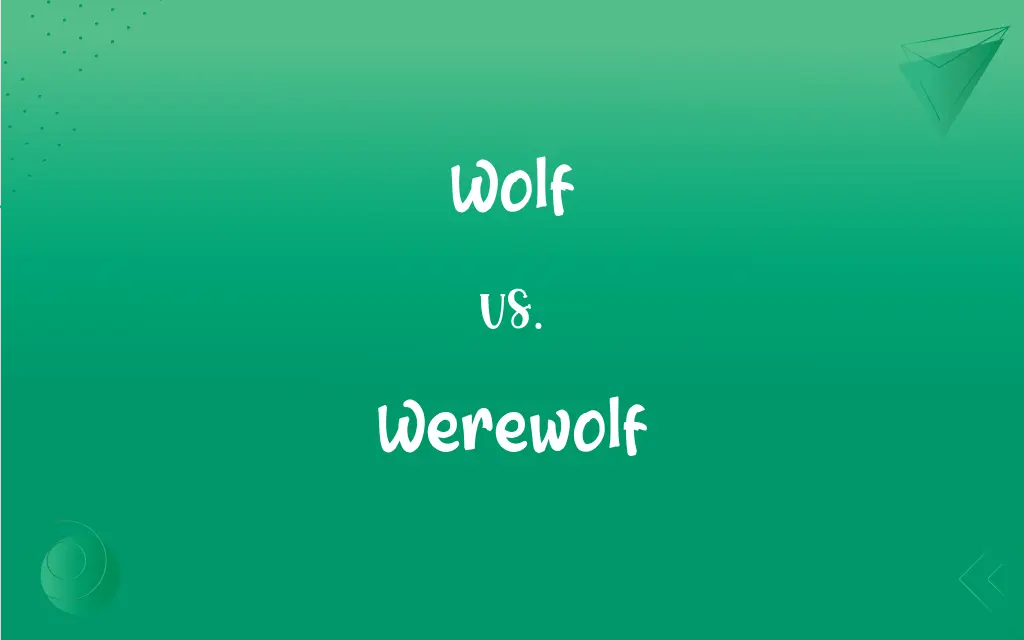Wolf vs. Werewolf: What's the Difference?
Edited by Aimie Carlson || By Janet White || Published on December 24, 2023
A wolf is a wild carnivorous mammal, while a werewolf is a mythical creature that is human but transforms into a wolf-like form.

Key Differences
A wolf is a real animal, known for its role in the wild as a carnivore and pack animal. A werewolf, in contrast, is a fictional creature from folklore, capable of transforming from human to wolf.
Wolves are known for their social structure, living and hunting in packs. Werewolves are depicted as humans who turn into wolves or wolf-like creatures, often during a full moon.
The wolf is a species in the Canidae family and plays a crucial role in ecosystem balance. Werewolves are a part of mythological stories and horror genres, symbolizing the struggle between human nature and animal instincts.
In terms of behavior, wolves communicate through howls and body language, crucial for their survival in the wild. Werewolves in folklore are often portrayed as losing their human consciousness when transformed, becoming more animalistic.
Conservation efforts worldwide aim to protect wolves, an endangered species in some regions. Werewolves, being mythical, are a popular subject in literature and media, reflecting cultural fears and fascination with the supernatural.
ADVERTISEMENT
Comparison Chart
Nature
Real animal
Mythical creature
Origin
Naturally occurring species
Originates from folklore and mythology
Behavior
Social, lives in packs
Human transforms into a wolf-like being
Role in Ecosystem
Predatory, ecosystem balance
Symbolic, representing inner conflict
Cultural Representation
Studied in wildlife biology
Featured in horror and fantasy genres
ADVERTISEMENT
Wolf and Werewolf Definitions
Wolf
A wolf is a mammal of the Canidae family.
The grey wolf is native to these woods.
Werewolf
A werewolf is a mythical creature that transforms from human to wolf.
The werewolf roamed the countryside at night.
Wolf
A wolf is a large wild canine.
The wolf howled under the moonlight.
Werewolf
A werewolf is often portrayed as a fearsome creature.
Villagers feared the howl of the werewolf.
Wolf
Wolf refers to a carnivorous pack animal.
Wolves hunt together for prey.
Werewolf
Werewolf signifies a symbolic struggle between humanity and animalistic instincts.
In the movie, the werewolf battled its own nature.
Wolf
Wolf signifies a predator in wild ecosystems.
The wolf plays a key role in the food chain.
Werewolf
A werewolf is a character in folklore and horror.
The story of the werewolf has been told for centuries.
Wolf
A wolf is known for its distinctive howl.
The sound of the wolf's howl echoed through the forest.
Werewolf
Werewolf refers to a human with the ability to change into a wolf-like form.
Legend says the werewolf turns under a full moon.
Wolf
Any of several carnivorous mammals of the genus Canis, especially the gray wolf of northern regions, that typically live and hunt in packs.
Werewolf
A person believed to have been transformed into a wolf or to be capable of assuming the form of a wolf.
Wolf
The fur of such an animal.
Werewolf
(mythology) A person who is transformed or can transform into a wolf or a wolflike human, often said to transform during a full moon. Category:en:Horror
Werewolf
A person transformed into a wolf in form and appetite, either temporarily or permanently, whether by supernatural influences, by witchcraft, or voluntarily; a lycanthrope. Belief in werewolves, formerly general, is not now extinct.
The werwolf went about his prey.
The brutes that wear our form and face,The werewolves of the human race.
Werewolf
A monster able to change appearance from human to wolf
FAQs
Are wolves endangered?
Yes, some wolf species are endangered due to habitat loss.
What triggers a werewolf transformation?
Commonly, it's depicted as occurring during a full moon.
Is the werewolf concept found worldwide?
Yes, variations of werewolf myths exist in many cultures.
What is the diet of a wolf?
Wolves are carnivores and primarily eat large ungulates.
Can wolves be domesticated?
No, wolves are wild animals and not suitable for domestication.
Do werewolves exist in reality?
No, they are purely mythical.
Are werewolves always evil in folklore?
Not always; interpretations vary, with some depicting them sympathetically.
Do wolves live alone or in packs?
Most wolves live and hunt in packs.
Where do wolves naturally live?
Wolves inhabit diverse environments, from forests to tundras.
How do wolves communicate?
Wolves communicate through howls, body language, and scents.
Are werewolves immortal?
In some myths, they are long-lived or immortal.
How are werewolves typically defeated in stories?
Commonly by silver weapons or other magical means.
Are werewolves affected by silver?
In most tales, silver is a werewolf's weakness.
What is the lifespan of a wolf?
Wolves live for about 6-8 years in the wild.
Are all wolves grey?
No, their fur can range from white to black.
Do wolves mate for life?
Some wolf pairs form long-term bonds.
Can werewolves pass their curse to others?
In many stories, the curse is transmitted through a bite.
Can werewolves control their transformation?
In most stories, they cannot control it.
Do werewolves have special powers?
Folklore often attributes them with enhanced strength or senses.
Can wolves be friendly to humans?
While some wolves tolerate human presence, they are generally not friendly.
About Author
Written by
Janet WhiteJanet White has been an esteemed writer and blogger for Difference Wiki. Holding a Master's degree in Science and Medical Journalism from the prestigious Boston University, she has consistently demonstrated her expertise and passion for her field. When she's not immersed in her work, Janet relishes her time exercising, delving into a good book, and cherishing moments with friends and family.
Edited by
Aimie CarlsonAimie Carlson, holding a master's degree in English literature, is a fervent English language enthusiast. She lends her writing talents to Difference Wiki, a prominent website that specializes in comparisons, offering readers insightful analyses that both captivate and inform.






































































